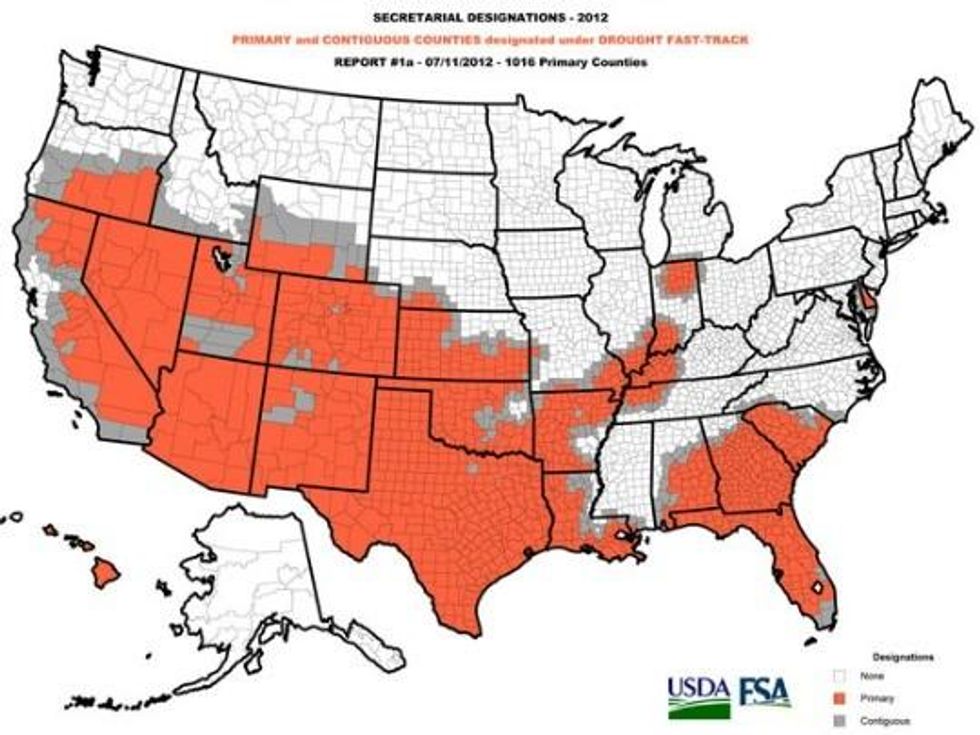USDA Declares 'Natural Disaster' in 26 States as Drought Devastates
The US Department of Agriculture declared a natural disaster on Thursday as a widespread drought stretched over 1,016 counties in 26 states, covering over half the country. The natural disaster is said to be the largest in US history due to its breadth.

The declaration will initiate a series of emergency loans for farmers in drought stricken areas; however, Agriculture Secretary Tom Vilsack said the low-interest loans and penalty reductions are only "limited tools" for relief.
According to the National Climatic Data Center, some parts of the Midwest have experienced the worst conditions since 1988 as crops and pastures continue to sizzle.
And the record setting drought does not seem to be easing any time soon. Scientists for the National Oceanic and Atmospheric Administration (NOAA) recently released a report which ties extreme weather events such as prolonged heat waves and drought to the broader implications of climate change. June temperatures revealed that once again the past 12 months have been the warmest on record in the US since the National Climatic Data Center began recording temperatures in 1895.
Subsequently, roughly 56% of the country is currently experiencing extreme drought conditions, the farthest reaching drought in over a decade, according to the US Drought Monitor.

An Urgent Message From Our Co-Founder
Dear Common Dreams reader, The U.S. is on a fast track to authoritarianism like nothing I've ever seen. Meanwhile, corporate news outlets are utterly capitulating to Trump, twisting their coverage to avoid drawing his ire while lining up to stuff cash in his pockets. That's why I believe that Common Dreams is doing the best and most consequential reporting that we've ever done. Our small but mighty team is a progressive reporting powerhouse, covering the news every day that the corporate media never will. Our mission has always been simple: To inform. To inspire. And to ignite change for the common good. Now here's the key piece that I want all our readers to understand: None of this would be possible without your financial support. That's not just some fundraising cliche. It's the absolute and literal truth. We don't accept corporate advertising and never will. We don't have a paywall because we don't think people should be blocked from critical news based on their ability to pay. Everything we do is funded by the donations of readers like you. Will you donate now to help power the nonprofit, independent reporting of Common Dreams? Thank you for being a vital member of our community. Together, we can keep independent journalism alive when it’s needed most. - Craig Brown, Co-founder |

The declaration will initiate a series of emergency loans for farmers in drought stricken areas; however, Agriculture Secretary Tom Vilsack said the low-interest loans and penalty reductions are only "limited tools" for relief.
According to the National Climatic Data Center, some parts of the Midwest have experienced the worst conditions since 1988 as crops and pastures continue to sizzle.
And the record setting drought does not seem to be easing any time soon. Scientists for the National Oceanic and Atmospheric Administration (NOAA) recently released a report which ties extreme weather events such as prolonged heat waves and drought to the broader implications of climate change. June temperatures revealed that once again the past 12 months have been the warmest on record in the US since the National Climatic Data Center began recording temperatures in 1895.
Subsequently, roughly 56% of the country is currently experiencing extreme drought conditions, the farthest reaching drought in over a decade, according to the US Drought Monitor.


The declaration will initiate a series of emergency loans for farmers in drought stricken areas; however, Agriculture Secretary Tom Vilsack said the low-interest loans and penalty reductions are only "limited tools" for relief.
According to the National Climatic Data Center, some parts of the Midwest have experienced the worst conditions since 1988 as crops and pastures continue to sizzle.
And the record setting drought does not seem to be easing any time soon. Scientists for the National Oceanic and Atmospheric Administration (NOAA) recently released a report which ties extreme weather events such as prolonged heat waves and drought to the broader implications of climate change. June temperatures revealed that once again the past 12 months have been the warmest on record in the US since the National Climatic Data Center began recording temperatures in 1895.
Subsequently, roughly 56% of the country is currently experiencing extreme drought conditions, the farthest reaching drought in over a decade, according to the US Drought Monitor.


